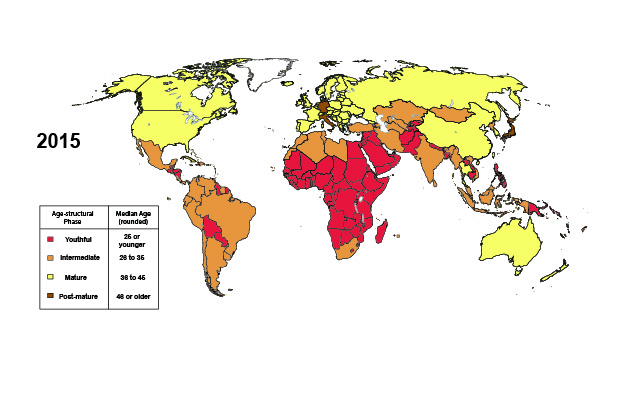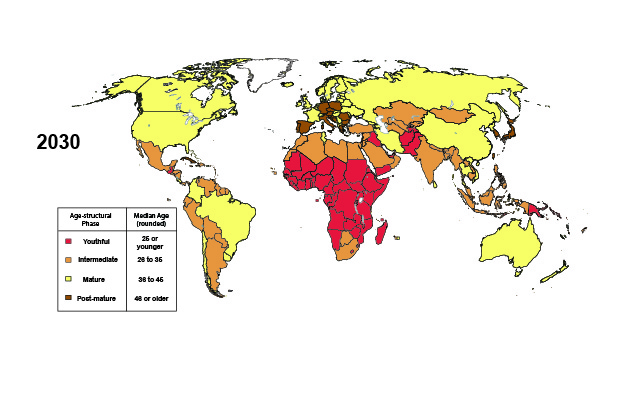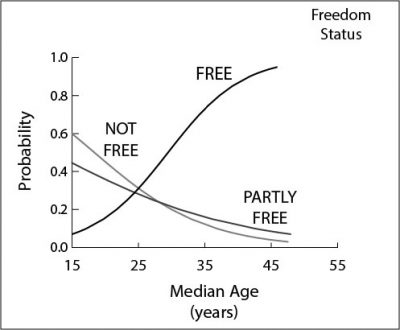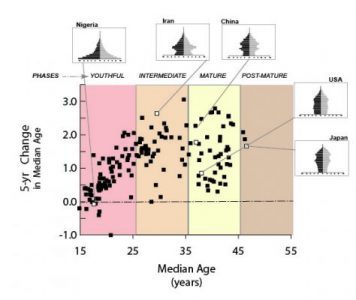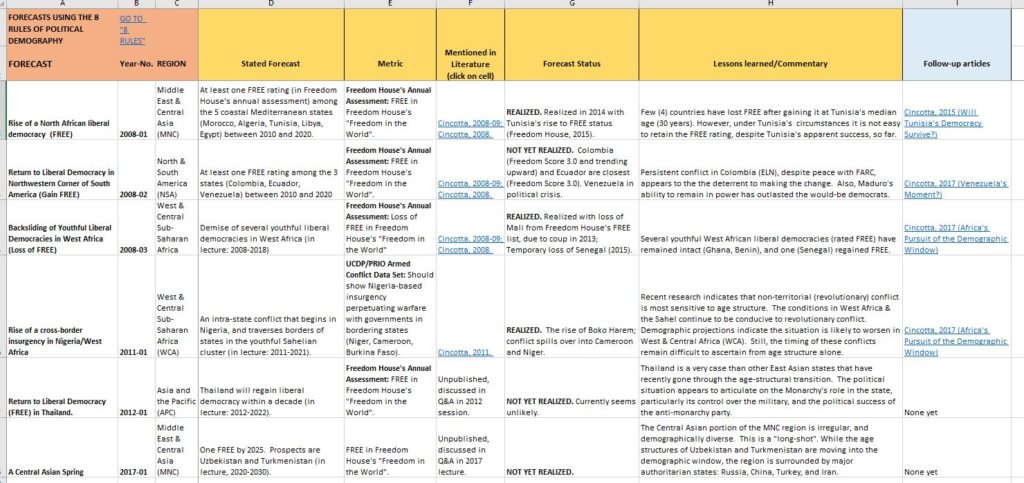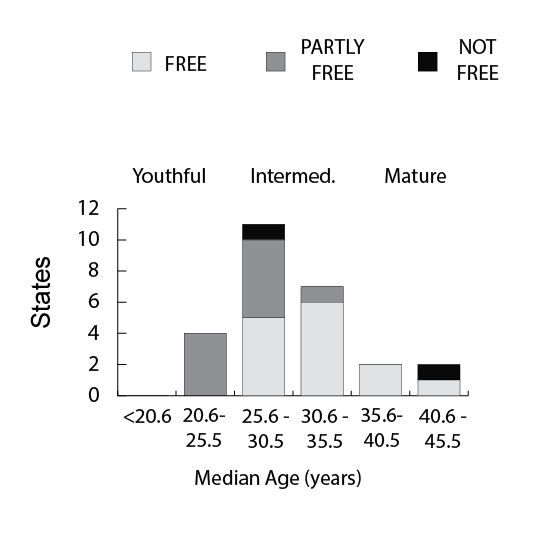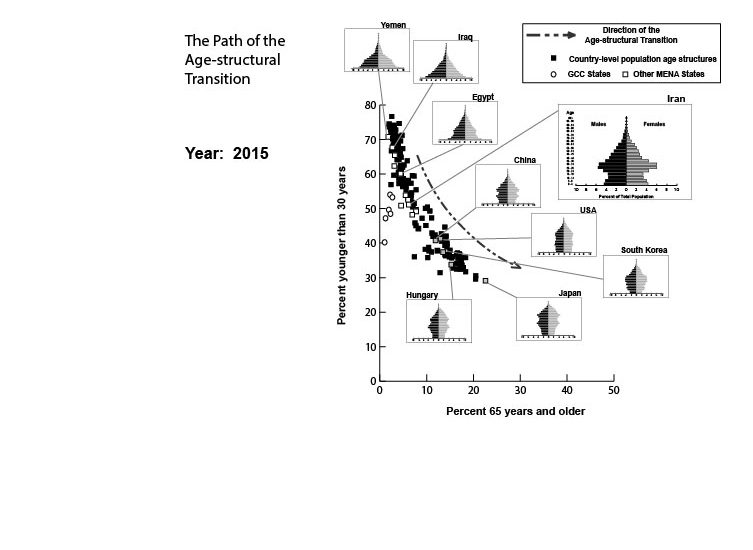
Welcome to politicaldemography.org
Separatist Conflicts Persist, While Revolutions Just “Age Away”
![]() Since the seminal research of Herbert Möller in the late 1960s and Jack Goldstone in the early 1990s, numerous political researchers have called attention to the tendency of countries with youthful populations—often called a “youth bulge”—to be more vulnerable to civil conflict than nearby states with a more mature population. Then a 2016 article upset political demography’s apple cart. When investigating countries with at least three consecutive years without an intra-state conflict, Omar Yair and Dan Miodownik found a fundamental difference between ethnic and non-ethnic warfare. The risk of a non-ethnic conflict was, indeed, higher under youth-bulge conditions. However, they found that youth bulges (measured at the country level, rather than at the ethnic level) were unrelated to the risk of an onset of an ethnic conflict.
Since the seminal research of Herbert Möller in the late 1960s and Jack Goldstone in the early 1990s, numerous political researchers have called attention to the tendency of countries with youthful populations—often called a “youth bulge”—to be more vulnerable to civil conflict than nearby states with a more mature population. Then a 2016 article upset political demography’s apple cart. When investigating countries with at least three consecutive years without an intra-state conflict, Omar Yair and Dan Miodownik found a fundamental difference between ethnic and non-ethnic warfare. The risk of a non-ethnic conflict was, indeed, higher under youth-bulge conditions. However, they found that youth bulges (measured at the country level, rather than at the ethnic level) were unrelated to the risk of an onset of an ethnic conflict.
La Différence Vit?
In research for a soon-to-be-published article, I set out to investigate a bit beyond Yair and Miodownik’s conclusions, asking two new questions:
- Do the differences that Yair and Miodownik observed extend to countries with a history of recent of conflict?
- How do these effects play out over the course of the age-structural transition—as populations age, shifting from a youthful population with a low median age, to a more mature population with a high median age?
For the rest of the article on New Security Beat … CLICK HERE. Or download briefing: “Revolutions Just Age Away” in .pdf.
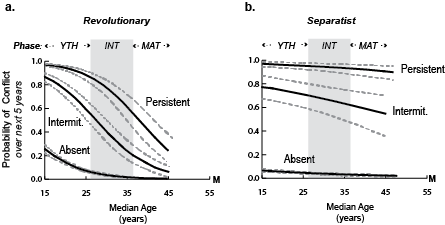 Fig. 1. The patterns of 5-year risk of (a.) revolutionary conflict and (b.) separatist conflict over the length of the age-structural transition. While the three types of conflict-history cases of revolutionary conflict (absent, intermittent, persistent) all respond to aging, the same classes of separatist conflict appear much less responsive.
Fig. 1. The patterns of 5-year risk of (a.) revolutionary conflict and (b.) separatist conflict over the length of the age-structural transition. While the three types of conflict-history cases of revolutionary conflict (absent, intermittent, persistent) all respond to aging, the same classes of separatist conflict appear much less responsive.
Conflict history classes: Absent: without conflict during the prior four years; Intermittent: 1 or 2 years of conflict during the prior 4 years; Persistent: 3 or 4 conflict years during the prior 4 years.
Attachments
Age-structural Forecasts (from the 8 Rules)
 Tracking Forecasts and Their Outcomes. It’s one thing to make timed forecasts (difficult), it’s another to track them (boring), note the successes and failures (a bit more interesting), and modify the theory to learn from the outcomes (painful). The theory behind these forecasts are summed up in the New Security Beat essay, “The 8 Rules of Political Demography“. Age-structural theory is covered in a longer article in the Oxford Research Encyclopedia of Politics.
Tracking Forecasts and Their Outcomes. It’s one thing to make timed forecasts (difficult), it’s another to track them (boring), note the successes and failures (a bit more interesting), and modify the theory to learn from the outcomes (painful). The theory behind these forecasts are summed up in the New Security Beat essay, “The 8 Rules of Political Demography“. Age-structural theory is covered in a longer article in the Oxford Research Encyclopedia of Politics.
The following spreadsheet (image posted below, downloadable here as an Excel Spreadsheet) is an effort to account for both the successes and failures of age-structural forecasts. Several forecasts have been discussed in lectures, but have not yet been published in either journals or in web essays. The next web essays will put these in print.
Attachments
Upcoming book: “Global Political Demography”
 “Global Political Demography” in progress [Sept. 2018]. Editors Achim Goerres (U. Duisburg-Essen) and Pieter Vanhuyesse (U. Southern Denmark) are currently managing the review and editing processes of Global Political Demography, which is scheduled to be published in 2019. The initial meeting of authors was held in November 2017, at the Käte Hamburger Kolleg/Center for Global Cooperation Research at the University of Duisburg-Essen, Germany. My contribution to this book is entitled, “Youthful Age Structures and the Risks of Revolutionary and Separatist Conflicts” (author: Richard Cincotta).
“Global Political Demography” in progress [Sept. 2018]. Editors Achim Goerres (U. Duisburg-Essen) and Pieter Vanhuyesse (U. Southern Denmark) are currently managing the review and editing processes of Global Political Demography, which is scheduled to be published in 2019. The initial meeting of authors was held in November 2017, at the Käte Hamburger Kolleg/Center for Global Cooperation Research at the University of Duisburg-Essen, Germany. My contribution to this book is entitled, “Youthful Age Structures and the Risks of Revolutionary and Separatist Conflicts” (author: Richard Cincotta).
Attachments
Demography: A Development Perspective
Security and Development in Global Politics: A Critical Comparison
Joanna Spear & Paul Williams, eds., Georgetown U. Press, 2012.
This excellent collection of articles on development and security has found its way into university classrooms. It contains two articles on politics, development, and demography that (I think) are essential reading for those interested in economic and political demography (the second article is downloadable from this website):
Goldstone, J. 2012. “Demography: A Security Perspective.” Pp. 271-289 in Security and Development in Global Politics: A Critical Comparison, edited by J. Spear and P.D. Williams. Washington, DC: Georgetown University Press.
Cincotta, R.P. 2012. “Demography: A Development Perspective.” Pp. 291-310 in Security and Development in Global Politics: A Critical Comparison, edited by J. Spear and P.D. Williams. Washington, DC: Georgetown University Press. [Download this extensive review of research on Demography and Development here]
Attachments
Nicaragua and the Last of Latin America’s Youthful Clusters
![]() After four months of political unrest and more than 250 deaths, the calls for Nicaragua’s embattled president Daniel Ortega to step down are escalating. One of political demography’s most robust statistical findings tells us that countries where an authoritarian government rules a youthful population, any change in regime typically yields an autocracy or at best, a partial democracy. Only very rarely has a liberal democracy emerged immediately after a rebellion in a youthful country (one with a population with a median age under 26 years). Given this, if Ortega is ousted from office, what type of leader should foreign
After four months of political unrest and more than 250 deaths, the calls for Nicaragua’s embattled president Daniel Ortega to step down are escalating. One of political demography’s most robust statistical findings tells us that countries where an authoritarian government rules a youthful population, any change in regime typically yields an autocracy or at best, a partial democracy. Only very rarely has a liberal democracy emerged immediately after a rebellion in a youthful country (one with a population with a median age under 26 years). Given this, if Ortega is ousted from office, what type of leader should foreign  affairs analysts expect to replace him?
affairs analysts expect to replace him?
There are good reasons to be optimistic. Nicaragua—now with a median age between 26 and 27 years—is no longer a youthful country. Fertility declined from around 6 children per woman in 1980 to about 2.2 today, gradually shifting Nicaragua into the intermediate phase of its age-structural transition, which (according to the National Intelligence Council’s Global Trends report) stretches from a median age of 26 to 35 years. More ….
Read the rest of the NSB essay on Nicaragua/Latin America here.
